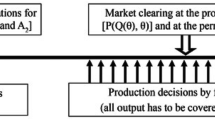Abstract
Emission trading system plays an increasingly important vole in reducing the pollution for environment. Through mathematical models, an analysis is made on the emissions trading system under an emission reduction framework. Four conclusions are drawn: (1) The impact by environmental taxes on the existing firm’s choices of optimal discharging amounts is uncertain, the existing firm’s discharging amounts will decrease with the increased prices of emissions permits, and paid initial emissions allowances will reduce the existing firm’s profits; (2) Under an intertemporal trading system, the existing firm’s holding permits conforms to the principle of profit maximization; (3) Under the intertemporal trading system, the prices for emissions permits for the entrant firms are always on the rise and so are their access costs into the industries, thus frustrating local governments’ efforts in attracting investments; and (4) Emissions reduction policy is a good regulatory measure for promoting local economic welfare and realizing sustainable development. Some suggestions are also given for triggering and activating the emissions trading system and formulating supportive policies, such as local governments are obliged to set prices for initial emissions permits to dampen the purchasing impulse of the existing firm and to avoid a thin market of emissions permits.

Similar content being viewed by others
References
Coase, R. H. (1960). The problem of social cost. Journal of Law & Economics, 3(0), 1–44.
Cronshaw, M., & Kruse, B. (1996). Regulated firms in pollution permit markets with banking. Journal of Regulatory Economics, 9(2), 179–189.
Ellerman, A. D., & Montero, J. P. (2002). The temporal efficiency of SO2 emission trading (Working Paper). CEEPR, MIT.
Heredia, F. J., Rider, M. J., & Corchero, C. (2012). A stochastic programming model for the optimal electricity market bid problem with bilateral contracts for thermal and combined cycle units. Annals of Operations Research, 193(1), 107–127.
Leiby, P., & Rubin, J. (2001). Intertemporal permit trading for the control of greenhouse gas emissions. Environmental & Resource Economics, 19(3), 229–256.
Malueg, D. A., & Yates, A. J. (2009). Strategic behavior, private information, and decentralization in the European union emissions trading system. Environmental & Resource Economics, 43(3), 413–432.
Manne, A. S., & Olsen, T. R. (1996). Greenhouse gas abatement—toward Pareto-optimal decisions under uncertainty. Annals of Operations Research, 68(2), 267–279.
Montgomery, W. D. (1972). Markets in licenses and efficient pollution control programs. Journal of Economic Theory, 5(3), 395–418.
Monjon, S., & Quirion, P. (2010). How to design a border adjustment for the European Union Emissions Trading System? Energy Policy, 38(9), 5199–5207.
Nagurney, A., & Dhanda, K. K. (2000). Noncompliant oligopolistic firms and marketable pollution permits: statics and dynamics. Annals of Operations Research, 95(1–4), 285–312.
Pigou, A. C. (1920). The economics of welfare (pp. 78–93). London: Macmillan and Co.
Piot-Lepetit, Isabelle (2010). Technological externalities and environmental policy: how to simulate manure management regulation within a DEA framework. Annals of Operations Research. doi:10.1007/s10479-010-0744-8.
Rose, A., & Stevens, B. (2001). An economic analysis of flexible permit trading in the Kyoto Protocol. International Environmental Agreements: Politics, Law and Economics, 1(2), 219–242.
Rubin, J. D. (1996). A model of intertemporal emission trading, banking, and borrowing. Journal of Environmental Economics and Management, 31(3), 269–286.
Skjaerseth, J. B., & Wettestad, J. (2010). Fixing the EU Emissions Trading System? Understanding the post-2012 changes. Global Environmental Politics, 10(4), 101–123.
Woerdman, E. (2000). Implementing the Kyoto protocol: why JI and CDM show more promise than international emissions trading. Energy Policy, 28(1), 29–38.
Acknowledgements
This article is supported by project of China’s soft science plan (2010GXS5D228) and project of science & technology plan of Shandong Province of China (2008RKA086).
Author information
Authors and Affiliations
Corresponding author
Rights and permissions
About this article
Cite this article
Song, ML., Zhang, W. & Qiu, XM. Emissions trading system and supporting policies under an emissions reduction framework. Ann Oper Res 228, 125–134 (2015). https://doi.org/10.1007/s10479-012-1152-z
Published:
Issue Date:
DOI: https://doi.org/10.1007/s10479-012-1152-z




